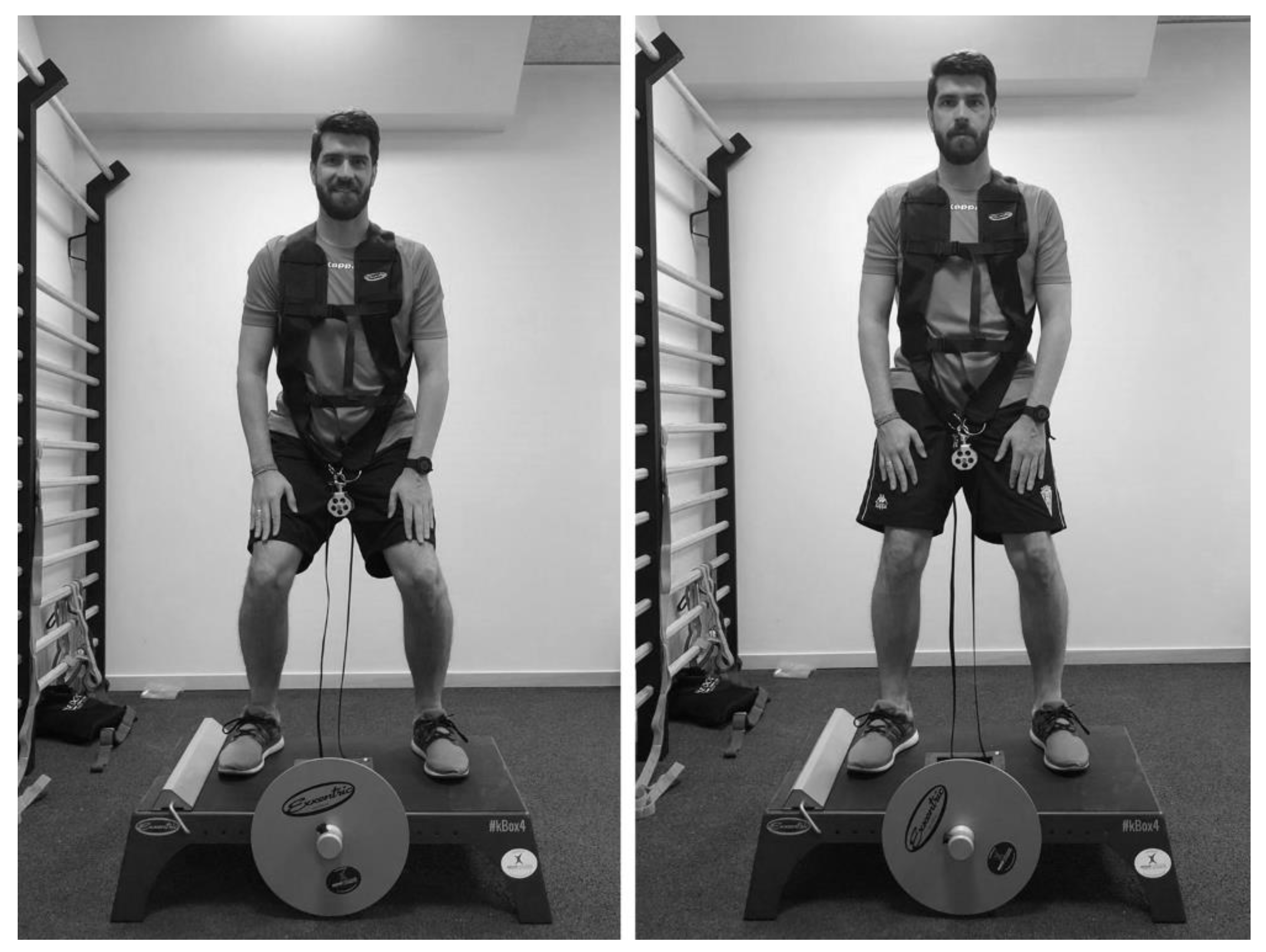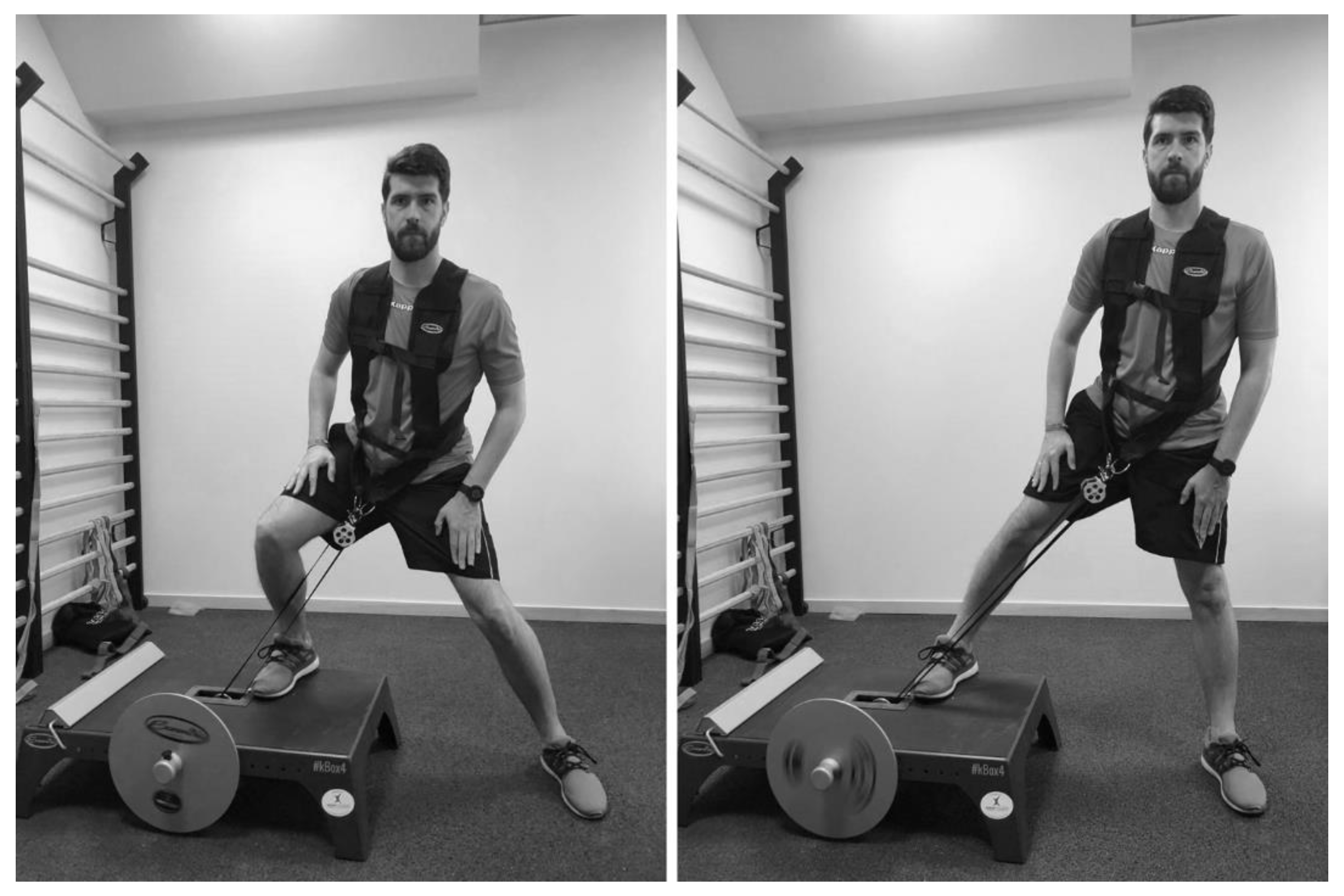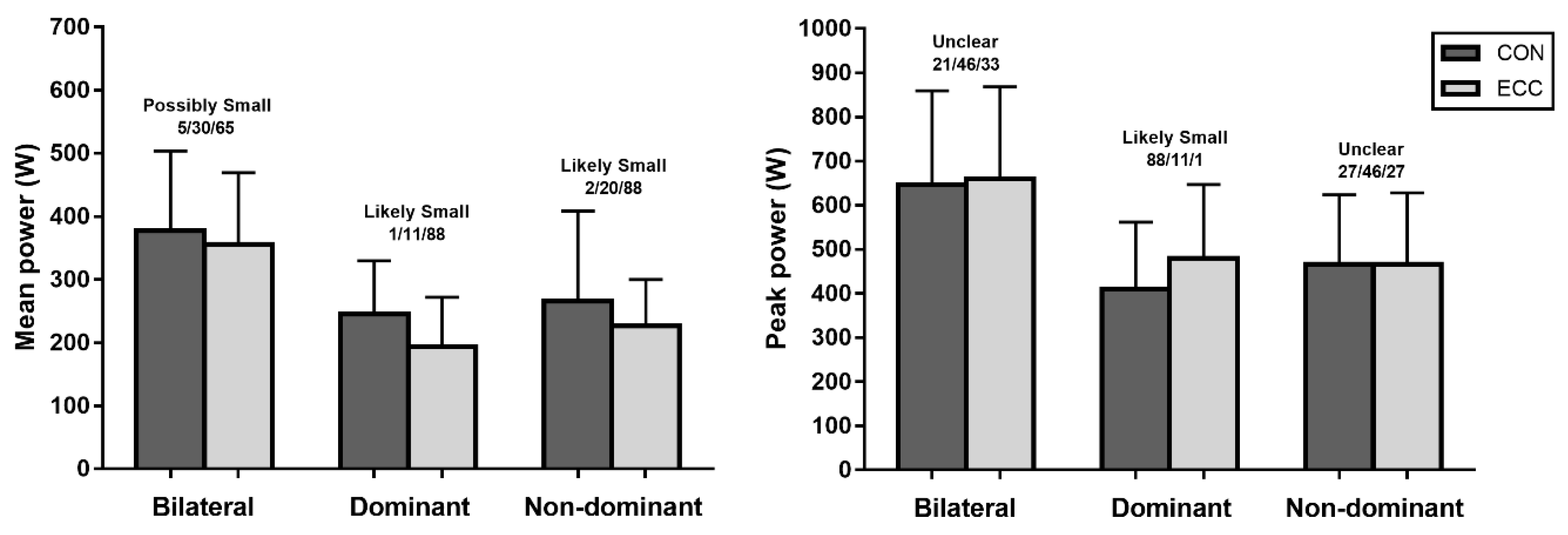Eccentric-Overload Production during the Flywheel Squat Exercise in Young Soccer Players: Implications for Injury Prevention
Abstract
1. Introduction
2. Materials and Methods
2.1. Participants
2.2. Experimental Design
2.3. Power Assessment
2.4. Statistical Analyses
3. Results
4. Discussion
5. Conclusions
Author Contributions
Funding
Acknowledgments
Conflicts of Interest
References
- Gonzalo-Skok, O.; Tous-Fajardo, J.; Suarez-Arrones, L.; Arjol-Serrano, J.L.; Casajús, J.A.; Mendez-Villanueva, A. Single-leg power output and between-limbs imbalances in team-sport players: Unilateral versus bilateral combined resistance training. Int. J. Sports Physiol. Perform. 2017, 12, 106–114. [Google Scholar] [CrossRef]
- Faude, O.; Koch, T.; Meyer, T. Straight sprinting is the most frequent action in goal situations in professional football. J. Sports Sci. 2012, 30, 625–631. [Google Scholar] [CrossRef]
- Ben Abdelkrim, N.; El Fazaa, S.; El Ati, J.; Tabka, Z. Time-motion analysis and physiological data of elite under−19-year-old basketball players during competition. Br. J. Sports Med. 2007, 41, 69–75. [Google Scholar] [CrossRef]
- Ade, J.; Fitzpatrick, J.; Bradley, P.S. High-intensity efforts in elite soccer matches and associated movement patterns, technical skills and tactical actions. Information for position-specific training drills. J. Sports Sci. 2016, 34, 2205–2214. [Google Scholar] [CrossRef]
- Swinton, P.A.; Lloyd, R.; Keogh, J.W.L.; Agouris, I.; Stewart, A.D. Regression models of sprint, vertical jump, and change of direction performance. J. Strength Cond. Res. 2014, 28, 1839–1848. [Google Scholar] [CrossRef]
- Castillo, D.; Domínguez, R.; Rodríguez-Fernández, A.; Raya-González, J. Effects of caffeine supplementation on power performance in a flywheel device: A randomised, double-blind cross-over study. Nutrients 2019, 11, 255. [Google Scholar] [CrossRef]
- Taber, C.; Bellon, C.; Abbott, H.; Bingham, G.E. Roles of maximal strength and rate of force development in maximizing muscular power. Strength Cond. J. 2016, 38, 71–78. [Google Scholar] [CrossRef]
- Case, M.J.; Knudson, D.V.; Downey, D.L. Barbell squat relative strength as an identifier for lower extremity injury in collegiate athletes. J. Strength Cond. Res. 2020, 34, 1249–1253. [Google Scholar] [CrossRef]
- Kraemer, W.J.; Newton, R.U. Training for muscular power. Phys. Med. Rehabil. Clin. N. Am. 2000, 11, 341–368. [Google Scholar] [CrossRef]
- Kraemer, W.J.; Fleck, S.J.; Evans, W.J. Strength and power training: Physiological mechanisms of adaptation. Exerc. Sport Sci. Rev. 1996, 24, 363–397. [Google Scholar] [CrossRef]
- Fernandez-Gonzalo, R.; Lundberg, T.R.; Alvarez-Alvarez, L.; de Paz, J.A. Muscle damage responses and adaptations to eccentric-overload resistance exercise in men and women. Eur. J. Appl. Physiol. 2014, 114, 1075–1084. [Google Scholar] [CrossRef]
- Norrbrand, L.; Fluckey, J.D.; Pozzo, M.; Tesch, P.A. Resistance training using eccentric overload induces early adaptations in skeletal muscle size. Eur. J. Appl. Physiol. 2008, 102, 271–281. [Google Scholar] [CrossRef]
- Hollander, D.B.; Kraemer, R.R.; Kilpatrick, M.W.; Ramadan, Z.G.; Reeves, G.V.; Francois, M.; Hebert, E.P.; Tryniecki, J.L. Maximal eccentric and concentric strength discrepancies between young men and women for dynamic resistance exercise. J. Strength Cond. Res. 2007, 21, 34–40. [Google Scholar] [CrossRef]
- Hortobagyi, T.; Hill, J.P.; Houmard, J.A.; Fraser, D.D.; Lambert, N.J.; Israel, R.G. Adaptive responses to muscle lengthening and shortening in humans. J. Appl. Physiol. 1996, 80, 765–772. [Google Scholar] [CrossRef]
- Julian, V.; Thivel, D.; Costes, F.; Touron, J.; Boirie, Y.; Pereira, B.; Perrault, H.; Duclos, M.; Richard, R. Eccentric training improves body composition by inducing mechanical and metabolic adaptations: A promising approach for overweight and obese individuals. Front. Physiol. 2018, 9, 1013. [Google Scholar] [CrossRef]
- Schoenfeld, B.; Grgic, J. Eccentric overload training: A viable to enhance muscle hypertrophy? Strength Cond. J. 2017, 40, 78–81. [Google Scholar] [CrossRef]
- Chaabene, H.; Prieske, O.; Negra, Y.; Granacher, U. Change of direction speed: Toward a strength training approach with accentuated eccentric muscle actions. Sport. Med. 2018, 48, 1773–1779. [Google Scholar] [CrossRef]
- Petersen, J.; Thorborg, K.; Nielsen, M.B.; Budtz-Jørgensen, E.; Hölmich, P. Preventive effect of eccentric training on acute hamstring injuries in men’s soccer: A cluster-randomized controlled trial. Am. J. Sports Med. 2011, 39, 2296–2303. [Google Scholar] [CrossRef]
- Berg, H.E.; Tesch, A. A gravity-independent ergometer to be used for resistance training in space. Aviat. Space. Environ. Med. 1994, 65, 752–756. [Google Scholar]
- Tesch, P.A.; Fernandez-Gonzalo, R.; Lundberg, T.R. Clinical applications of iso-inertial, eccentric-overload (YoYoTM) resistance exercise. Front. Physiol. 2017, 8, 241. [Google Scholar] [CrossRef]
- Maroto-Izquierdo, S.; García-López, D.; Fernandez-Gonzalo, R.; Moreira, O.C.; González-Gallego, J.; de Paz, J.A. Skeletal muscle functional and structural adaptations after eccentric overload flywheel resistance training: A systematic review and meta-analysis. J. Sci. Med. Sport 2017, 20, 943–951. [Google Scholar] [CrossRef]
- Maroto-Izquierdo, S.; García-López, D.; de Paz, J.A. Functional and muscle-size effects of flywheel resistance training with eccentric-overload in professional handball players. J. Hum. Kinet. 2017, 60, 133–143. [Google Scholar] [CrossRef]
- Núñez, F.J.; Santalla, A.; Carrasquila, I.; Asian, J.A.; Reina, J.I.; Suarez-Arrones, L.J. The effects of unilateral and bilateral eccentric overload training on hypertrophy, muscle power and COD performance, and its determinants, in team sport players. PloS ONE 2018, 13, e0193841. [Google Scholar] [CrossRef]
- De Hoyo, M.; Pozzo, M.; Sanudo, B.; Carrasco, L.; Gonzalo-Skok, O.; Dominguez-Cobo, S.; Moran-Camacho, E. Effects of a 10-week in-season eccentric overload training program on muscle injury prevention and performance in junior elite soccer players. Int. J. Sports Physiol. Perform. 2015, 10, 46–52. [Google Scholar] [CrossRef]
- Tous-Fajardo, J.; Gonzalo-Skok, O.; Arjol-Serrano, J.L.; Tesch, P. Enhancing change-of-direction speed in soccer players by functional inertial eccentric overload and vibration training. Int. J. Sports Physiol. Perform. 2016, 11, 66–73. [Google Scholar] [CrossRef]
- Gonzalo-Skok, O.; Tous-Fajardo, J.; Valero-Campo, C.; Berzosa, C.; Bataller, A.V.; Arjol-Serrano, J.L.; Moras, G.; Mendez-Villanueva, A. Eccentric-overload training in team-sport functional performance: Constant bilateral vertical versus variable unilateral multidirectional movements. Int. J. Sports Physiol. Perform. 2017, 12, 951–958. [Google Scholar] [CrossRef]
- Gonzalo-Skok, O.; Tous-Fajardo, J.; Arjol-Serrano, J.L.; Suarez-Arrones, L.; Antonio Casajús, J.; Mendez-Villanueva, A. Improvement of repeated-sprint ability and horizontal-jumping performance in elite young basketball players with low-volume repeated-maximal-power training. Int. J. Sports Physiol. Perform. 2016, 11, 464–473. [Google Scholar] [CrossRef]
- Gual, G.; Fort-Vanmeerhaeghe, A.; Romero-Rodríguez, D.; Tesch, P.A. Effects of in-season inertial resistance training with eccentric overload in a sports population at risk for patellar tendinopathy. J. Strength Cond. Res. 2016, 30, 1834–1842. [Google Scholar] [CrossRef]
- Fisher, J.P.; Ravalli, S.; Carlson, L.; Bridgeman, L.A.; Roggio, F.; Scuderi, S.; Maniaci, M.; Cortis, C.; Fusco, A.; Musumeci, G. Utility and Advantages of the Eccentric Training through the Isoinertial System. J. Funct. Morphol. Kinesiol. 2020, 5, 6. [Google Scholar] [CrossRef]
- McCall, A.; Dupont, G.; Ekstrand, J. Injury prevention strategies, coach compliance and player adherence of 33 of the UEFA Elite Club Injury Study teams: A survey of teams’ head medical officers. Br. J. Sports Med. 2016, 50, 725–730. [Google Scholar] [CrossRef]
- McCall, A.; Carling, C.; Davison, M.; Nedelec, M.; Le Gall, F.; Berthoin, S.; Dupont, G. Injury risk factors, screening tests and preventative strategies: A systematic review of the evidence that underpins the perceptions and practices of 44 football (soccer) teams from various premier leagues. Br. J. Sports Med. 2015, 49, 583–589. [Google Scholar] [CrossRef]
- Svensson, K.; Eckerman, M.; Alricsson, M.; Magounakis, T.; Werner, S. Muscle injuries of the dominant or non-dominant leg in male football players at elite level. Knee Surg. Sport. Traumatol. Arthrosc. 2018, 26, 933–937. [Google Scholar] [CrossRef]
- Coratella, G.; Beato, M.; Cè, E.; Scurati, R.; Milanese, C.; Schena, F.; Esposito, F. Effects of in-season enhanced negative work-based vs traditional weight training on change of direction and hamstrings-to-quadriceps ratio in soccer players. Biol. Sport 2019, 36, 241–248. [Google Scholar] [CrossRef]
- Hopkins, W.G. Spreadsheets for analysis of controlled trials, with adjustment for a subject characteristic. Sportscience 2006, 10, 46–50. [Google Scholar]
- Hopkins, W.G.; Marshall, S.W.; Batterham, A.M.; Hanin, J. Progressive Statistics for studies in sports medicine and exercise science. Med. Sci. Sport. Exerc. 2009, 41, 3–13. [Google Scholar] [CrossRef]
- Fousekis, K.; Tsepis, E.; Vagenas, G. Lower limb strength in professional soccer players: Profile, asymmetry, and training age. J. Sports Sci. Med. 2010, 9, 364–373. [Google Scholar]
- Rahnama, N.; Lees, A.; Bambaecichi, E. A comparison of muscle strength and flexibility between the preferred and non-preferred leg in English soccer players. Ergonomics 2005, 48, 1568–1575. [Google Scholar] [CrossRef]
- Wong, P.; Chamari, K.; Chaouachi, A.; Mao, D.W.; Wisløff, U.; Hong, Y. Difference in plantar pressure between the preferred and non-preferred feet in four soccer-related movements. Br. J. Sports Med. 2007, 41, 84–92. [Google Scholar] [CrossRef]
- Daneshjoo, A.; Rahnama, N.; Mokhtar, A.H.; Yusof, A. Bilateral and unilateral asymmetries of isokinetic strength and flexibility in male young professional soccer players. J. Hum. Kinet. 2013, 36, 45–53. [Google Scholar] [CrossRef]
- Madruga-Parera, M.; Bishop, C.; Fort-Vanmeerhaeghe, A.; Beato, M.; Gonzalo-Skok, O.; Romero-Rodríguez, D. Effects of 8 weeks of isoinertial vs. cable-resistance training on motor skills performance and interlimb asymmetries. J. Strength Cond. Res. 2020. [Google Scholar] [CrossRef]
- Martinez-Aranda, L.M.; Fernandez-Gonzalo, R. Effects of inertial setting on power, force, work, and eccentric overload during flywheel resistance exercise in women and men. J. Strength Cond. Res. 2017, 31, 1653–1661. [Google Scholar] [CrossRef] [PubMed]
- Sabido, R.; Hernández-Davó, J.L.; Pereyra-Gerber, G.T. Influence of different inertial loads on basic training variables during the flywheel squat exercise. Int. J. Sports Physiol. Perform. 2018, 13, 482–489. [Google Scholar] [CrossRef] [PubMed]
- Sabido, R.; Hernández-Davó, J.L.; Botella, J.; Navarro, A.; Tous-Fajardo, J. Effects of adding a weekly eccentric-overload training session on strength and athletic performance in team-handball players. Eur. J. Sport Sci. 2017, 17, 530–538. [Google Scholar] [CrossRef] [PubMed]
- Tous-Fajardo, J.; Maldonado, R.A.; Quintana, J.M.; Pozzo, M.; Tesch, P.A. The flywheel leg-curl machine: Offering eccentric overload for hamstring development. Int. J. Sports Physiol. Perform. 2006, 1, 293–298. [Google Scholar] [CrossRef]
- Nuñez, F.J.; Sáez de Villarreal, E. Does flywheel paradigm training improve muscle volume and force? A Meta-Analysis. J. Strength Cond. Res. 2017, 31, 3177–3186. [Google Scholar] [CrossRef]



| Variables | Dominant Leg | Non-Dominant Leg | Mean Difference; ± 90% CL | ES; ± 90% CL | Qualitative Inference | Rating |
|---|---|---|---|---|---|---|
| MPcon (W) | 244.89 ± 85.04 | 265.62 ± 87.43 | 9.1; ±24.8 | 0.23; ± 0.55 | Unclear | 54/37/9 |
| MPecc (W) | 194.18 ± 77.72 | 226.44 ± 73.07 | 19.2; ±27.7 | 0.40; ± 0.52 | Likely Small | 75/23/2 |
| PPcon (W) | 410.33 ± 151.26 | 467.08 ± 156.83 | 14.8; ± 26.6 | 0.36; ± 0.55 | Possibly Small | 69/27/5 |
| PPecc (W) | 466.58 ± 161.26 | 479.69 ± 167.48 | 2.1; ± 23.0 | 0.07; ± 0.53 | Unclear | 35/46/19 |
© 2020 by the authors. Licensee MDPI, Basel, Switzerland. This article is an open access article distributed under the terms and conditions of the Creative Commons Attribution (CC BY) license (http://creativecommons.org/licenses/by/4.0/).
Share and Cite
Raya-González, J.; Castillo, D.; Domínguez-Díez, M.; Hernández-Davó, J.L. Eccentric-Overload Production during the Flywheel Squat Exercise in Young Soccer Players: Implications for Injury Prevention. Int. J. Environ. Res. Public Health 2020, 17, 3671. https://doi.org/10.3390/ijerph17103671
Raya-González J, Castillo D, Domínguez-Díez M, Hernández-Davó JL. Eccentric-Overload Production during the Flywheel Squat Exercise in Young Soccer Players: Implications for Injury Prevention. International Journal of Environmental Research and Public Health. 2020; 17(10):3671. https://doi.org/10.3390/ijerph17103671
Chicago/Turabian StyleRaya-González, Javier, Daniel Castillo, Marta Domínguez-Díez, and José Luis Hernández-Davó. 2020. "Eccentric-Overload Production during the Flywheel Squat Exercise in Young Soccer Players: Implications for Injury Prevention" International Journal of Environmental Research and Public Health 17, no. 10: 3671. https://doi.org/10.3390/ijerph17103671
APA StyleRaya-González, J., Castillo, D., Domínguez-Díez, M., & Hernández-Davó, J. L. (2020). Eccentric-Overload Production during the Flywheel Squat Exercise in Young Soccer Players: Implications for Injury Prevention. International Journal of Environmental Research and Public Health, 17(10), 3671. https://doi.org/10.3390/ijerph17103671







